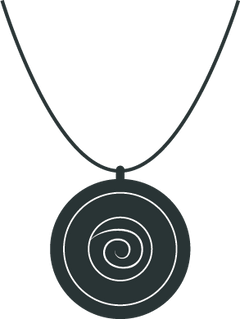Your Cart is Empty
We get it. The idea of slapping on a sticker or donning a pendant to ward off the evils of EMF radiation is tempting. However, the claims behind these products lack the scientific rigor needed to be taken seriously.
US VS. THEM
No fake science, no false claims, just 100% science-backed signal blocking. SLNT®holds multiple RF blocking utility patents, and is trusted by the most elite military and intelligence agencies.
For 10+ years, SLNT®has lead the market as the #1 signal blocking brand.
Blocks 100% of EMF Radiation
Third Party Signal Blocking Testing (with actual science)
Holds a Utility Patent
Literally a Scam
ALWAYS- 3rd party testing by Keystone Labs, real world testing by U.S. Military
YES, several
(not to brag)
NEVER
Physiological response, aka self-determined placebo
NO
SCAM
Physiological response, aka self-determined placebo
NO
SCAM
"Testing uses faulty data, not tested with actual product
NO
SCAM
-
There is no magic, these do NOT work.
In a world where we're constantly seeking protection from the invisible threats of EMF radiation, it's no surprise that a market has emerged, promising easy solutions. Enter the realm of EMF "protection" stickers and pendants.
We get it. The idea of slapping on a sticker or donning a pendant to ward off the evils of EMF radiation is tempting. It's simple, it's quick, and it's fashionable. However, the claims behind these products often lack the scientific rigor needed to be taken seriously. Endorsements from well-known personalities and a flurry of positive peer reviews often accompany these products. Yet, dig a little deeper and the scientific backing often turns out to be shallow or non-existent.
Claims of substantial funding and extensive research into the development of these "protective" stickers may be flaunted. However, the testing often cited leans heavily on self-reported physiological responses, which may indicate a placebo effect rather than genuine protective efficacy against EMF radiation. The sleek marketing campaigns of these products often meld purported human benefits with scientific jargon, creating a facade of credibility. However, without rigorous scientific backing, these claims remain unverified, potentially misleading consumers.
Instead of falling for glossy marketing or unproven products, consider focusing on established methods to reduce EMF exposure. Utilizing speakerphones, opting for wired headphones, and maintaining a distance from EMF sources are pragmatic steps towards minimizing risk. Informed choices based on sound scientific principles provide a more reliable shield against EMF radiation, promoting both awareness and safety.
-
Electromagnetic fields (EMF) are among the most rapidly growing environmental influences, and they've been a part of our universe since its inception. While light is the most familiar form of electromagnetic radiation, the spectrum extends from static electric and magnetic fields to X-rays. It's crucial to understand that not all EMFs are harmful. For instance, the Earth itself has a natural magnetic field. The challenge lies in discerning between everyday, benign exposures and those that are high-intensity and prolonged.
Key Insights:
- The ubiquity of EMFs: EMFs of all frequencies are now a common environmental influence, and as technology progresses, our exposure to them will only increase.
- Natural vs. Man-made: Electromagnetic radiation has always existed, with light being its most recognizable form. However, with technological advancements, man-made sources of EMFs, such as our gadgets and appliances, have become more prevalent.
- The Spectrum: The spectrum of electromagnetic radiation ranges from static electric and magnetic fields to more intense forms like X-rays.
-
These examples highlight the importance of skepticism and the need for rigorous scientific evaluation before accepting the safety and efficacy of any product or treatment.
Just because a product or technology is widely available doesn't guarantee its safety. Technological regulations can sometimes be slow to catch up, and economic interests can overshadow health concerns. Throughout history, there have been numerous products and treatments that were initially believed to be beneficial or even miraculous, only to be discovered as harmful later on. Here are a few examples:Radioactive Drinks: In the early 1900s, radioactivity was believed to have health benefits. Radioactive drinks were marketed to the public, with some even claiming to drink multiple bottles a day. The dangers of radiation became evident when adverse effects, including severe health issues, began to surface.
Heroin Cough Suppressant:Developed by Bayer Laboratories in 1898, heroin was used as a cough syrup. Its addictive properties were soon realized, leading to its discontinuation and eventual outlawing.
Cigarettes: Once deemed healthy and encouraged, it took years of research and a public health crisis to reveal the severe health risks associated with smoking.
Car Safety: The absence of seat belts in cars until a tipping point in safety regulations showcased how incremental safety improvements can significantly reduce risks.
Asbestos: Widely used until banned in the 70s, asbestos is a prime example of how long-term exposure to a seemingly harmless substance can lead to severe health issues, such as cancer
These historical cases may offer a glimpse into the uncertainties surrounding the potential long-term effects of prolonged cell phone usage. While using a cell phone for a short period might not pose significant risks, the cumulative effects over years or a lifetime are yet to be fully understood. Incremental changes in our habits today, aligned with the principle of longevity, could mitigate unforeseen risks in the future.
Moreover, it's a sobering reminder that many products currently in the market might not have undergone rigorous safety evaluations, potentially posing unforeseen risks. This emphasizes the importance of skepticism and the necessity for thorough scientific evaluation before accepting the safety and efficacy of any product.
-
The world of EMF protection products is vast, but not all are as effective as they claim. Here's a deeper dive based on insights from Consumer Reports:
- RF Radiation from Devices: Devices like cell phones, WiFi, and Bluetooth emit radiofrequency radiation (RF). While RF waves from cell phones are of concern due to their proximity to our bodies, the radiation from WiFi and Bluetooth devices is typically weaker. This is because these signals travel shorter distances, like between a router and a laptop, and can be transmitted at lower power levels.
- Distance is Key: The strength of RF signals drops dramatically as the distance from the body increases. For instance, using Bluetooth headphones, which are close to the body, may pose less risk than cell phones due to their weaker signals. An even more effective strategy is using a device's speaker, allowing you to keep the phone away from the body entirely.
- Uncertainties Remain: While there are reasons to believe that WiFi and Bluetooth may pose less risk than cell phones, definitive conclusions are elusive. For instance, while exposure from a single home router may be minimal, the cumulative effect in areas with multiple devices, like school classrooms, could be of concern. Moreover, children's developing bodies might be more susceptible to radiation from devices.
- Precautionary Measures: Some school districts, recognizing potential risks, have taken steps to reduce RF radiation exposure. For example, the Maryland State Department of Education recommended using wired networks over WiFi, turning off routers when not in use, and positioning routers away from students.
Source:Consumer Reports on Radiation from WiFi and Bluetooth Devices.
FICTION
-
The FCC's SAR (Specific Absorption Rate) Standard, which measures the rate at which our bodies absorb energy from radio frequency (RF) electromagnetic fields, hasn't been updated since 1996. Think about it: our cell phones have undergone massive transformations since the '90s, both in design and functionality. Yet, the safety standards that oversee them remain static.
SAR values are pivotal as they indicate the potential risks associated with RF energy exposure from cell phones. With the introduction of 5G and increased wireless device reliance, the spectrum of RF exposure has expanded. This evolution underscores the urgent need to revisit and modernize SAR standards. As technology advances, our safety guidelines must evolve in tandem to ensure we're protected while enjoying the conveniences of modern devices.
Source:FCC's SAR Standards.
-
The National Institute of Health (NIH) has conducted extensive research into the potential health effects of radiofrequency radiation (RFR), a type of EMF emitted by devices like cell phones. Here's what their findings reveal:
- Tumor Activity in Rodents: High exposure to RFR resulted in tumors in tissues surrounding nerves in the hearts of male rats. Notably, these exposure levels were equal to and even higher than the highest level permitted for local tissue exposure in current cell phone emissions.
- Significant Findings: The incidence of tumors, known as malignant schwannomas, increased in male rats with higher RFR exposure levels. Additionally, researchers observed an unusual pattern of cardiomyopathy, or damage to heart tissue, in both male and female rats exposed to RFR.
- Other Potential Risks: The report also highlighted statistically significant increases in the number of rats and mice with tumors in various organs, including the brain, prostate gland, pituitary gland, adrenal gland, liver, and pancreas. However, it's still unclear if these tumor increases are directly related to RFR.
- Context is Crucial: It's essential to note that the levels and duration of RFR exposure in these studies were much greater than what humans typically experience. While the tumors observed are similar to those reported in some studies of frequent cell phone users, direct extrapolation to human cell phone usage requires caution.
Source:NIH Study on RF Radiation.
-
In the age of the internet, information is at our fingertips. But with the ease of access comes the challenge of discerning accurate information from myths. When it comes to EMF, many websites, blogs, and forums are rife with inaccurate information.
Some sites may exaggerate the dangers of EMF to promote their protective products, while others might downplay the risks to support certain industries or technologies. It's essential to approach online information with a critical mind.
Before accepting any claim, consider the source. Is it from a reputable organization? Are there references to scientific studies? Remember, anecdotal evidence or personal testimonials are not substitutes for peer-reviewed research.
In the digital age, being informed means not just accessing information but also critically evaluating its credibility. When in doubt, turn to established scientific institutions and peer-reviewed journals for guidance on EMF.
-
The relationship between distance, duration, and EMF exposure is straightforward: the closer and longer you are to an EMF source, the greater the exposure. This is especially relevant considering our reliance on devices like smartphones and laptops. Here are some insights from the CDC:
- Cell Phones and Radiation: Cell phones and cordless phones emit radiofrequency radiation (RF). While RF is different from more harmful types of radiation like X-rays, the long-term health effects of RF radiation are still under investigation.
- Reducing RF Exposure: To minimize the risk, the CDC recommends using hands-free headsets or the speaker-phone function more often. For those with pacemakers, there were past concerns about RF interference, so it's advised to consult with healthcare providers about any potential risks.
- Ongoing Research: The World Health Organization (WHO) and other bodies are continuously studying the potential health effects of cell phone use, including the possible association with certain types of health conditions.
Source:CDC on Cell Phones and Health.
-
5G, the next-gen wireless technology, has sparked health concerns:
- FCC's Outdated Limits: The Federal Communications Commission (FCC) plans to reaffirm 1990s RFR exposure limits, but over 500 studies since then suggest potential non-thermal health risks.
- Scientific Appeal: Over 240 scientists have called for stronger EMF exposure limits, citing risks like cancer, cellular stress, and genetic damage.
- A Need for More Research: With limited data on 5G's health effects and evidence of risks from previous generations, there's a call for caution and further study.
- Ongoing Debate: Since 2011, RF radiation has been classified as a Group 2B “possible” human carcinogen by the International Agency on Cancer (IARC), an agency of the World Health Organization. However, the debate continues, with some experts calling for a reclassification to a “probable” human carcinogen based on new findings.
Source:Scientific American on 5G Safety.






















